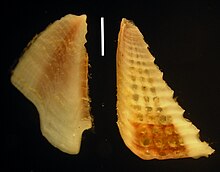Tergite
As Tergit or Tergum ( latin tergum , back ') or back plate , the dorsal (back side) sclerite , a sclerotized Chitinplatte of the exoskeleton of arthropods designated. It is part of the body segments , which on the outside also consist of a belly plate ( sternite ) connected to the tergite by two lateral flank skins or flank plates ( pleurites ) . Processes of the tergites are called tergal processes .
Special features of different animal groups
- insects
In insects , the front section of the abdominal tergum is called the notum , and the rear section is called the postnotum. The tergum of the chest section of flightable insects is particularly stiffened, because it represents the main attachment of the wing muscles. At the same time, the sclerites are flexible against neighboring sclerites of the tergum in order to support the wing and muscle movements while saving energy.
- Millipede
In bilipedes ( millipedes ), the rear tergites each cover two segments (each with two sternites and two pairs of legs).
The tergites of the 2nd to 6th segments of puntipods each cover a segment and each have a clearly visible sensory organ in the form of a long bristle ( trichobothrium ). The back plates can be reduced in other segments.
It is the other way around with pygmy pods : they sometimes even form two back plates per segment.
- Crustaceans
Crustaceans often have hard coverings on the upper side of the body, with barnacles as a distinct tergum. In higher crustaceans , head structures with tergites of several segments are fused to form a uniform surface, the carapace .
Individual evidence
- ↑ a b sclerite . In: Herder Lexicon of Biology, Seventh Volume praealpin bis Spindelstrauch, Spektrum Akademischer Verlag, Heidelberg / Berlin / Oxford 1994, ISBN 3-86025-156-2 , p. 440.
- ↑ a b c d Carl R. Knospe: Insect flight mechanisms: Anatomy and kinematics. (PDF) University of Virginia, Tech. Rep 1998.
- ^ Gerhard Mickoleit: On the phylogenetic and functional importance of the so-called emergency organs of the Mecoptera (Insecta, Mecoptera). In: Zoomorphology 69, No. 1, 1971, pp. 1-8.
- ↑ Ralf Janssen, Nikola-Michael Prpic, Wim GM Damen: A review of the correlation of tergites, sternites, and leg pairs in diplopods. In: Frontiers in Zoology 3, No. 2, February 2006, doi: 10.1186 / 1742-9994-3-2 (PDF).
- ^ BA Foster: A guide to the littoral balanomorph barnacles of New Zealand. In: Tuatara 15, 1967, pp. 75-86.

